Monza - from 8 September 1943 to 25 April 1945

The Topography of Terror
Today the quadrilateral area around the Villa Reale in Mona is leafy upmarket residential area, with quiet streets and expensive gated apartment buildings mixed with some of the original historic villas, built by Milanese or Mona industrialists. Many of the older villas have been torn down and replaced by new buildings, with the only sign of the past being the high walls and extensive gardens. Between September 1943 and April 1945, the situation was vastly different. When the Germans occupied Monza on 11 September 1943, they took advantage of the limited access, the high walls, and the large villas available to establish a fortified zone in the quadrilateral area, surrounded by razor wire and with access controlled by guards, dogs and armoured vehicles. Via Giuseppe Verdi 1 on the corner with viale Regina Margherita and the surrounding villas became the nerve centre of Nazi-Fascist anti-partisan operations in NW Italy. This was the HQ of SS Brigadefuehrer und Generalmajor der Polizei, Willy (Willi) Tensfeld with a force of some 300 men, tanks and transport vehicles. Tensfeld was head of Police and anti-guerrilla operations for “Oberitalien West” and from Monza, he directed German and Italian anti-partisan operations for the whole the triangle Milan- Genoa-Turin ( the regions of Lombardy, Piemonte and Liguria). Also, in the same area at via Tommaso Grossi,12 was the SS Sicherungskompanie, commanded by SS Unterscharfuehrer Siegfried Werning. Despite, holding a rank equivalent to Sergeant Major, Werning was possibly the most feared man in Monza responsible for security in the city and for the detention and torture of many citizens during the dark 18 months of occupation.
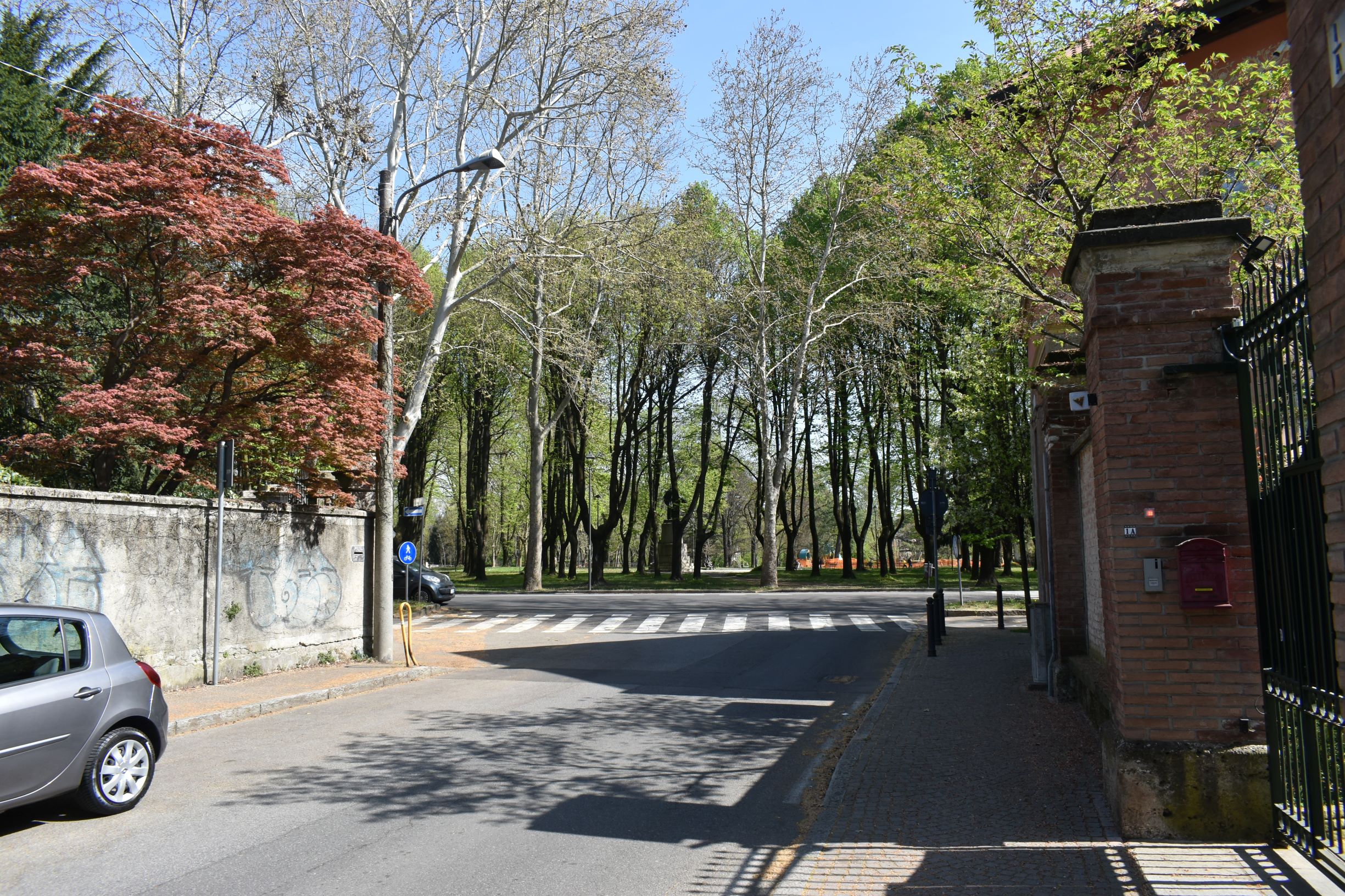
Via Giuseppe Verdi looking out onto the Boschetti Reale. This formed the edge of the area taken over by the SS as their HQ.
A few hundred metres away, the forces of Mussolini’s Repubblica Sociale Italiana had installed themselves in the Villa Reale. Here, were the offices of the Fascist Militia, the MVSN and the notorious Political Investigative Police, UPI, presided over by Maggiore Luigi (Gino) Gatti, responsible for hunting down and detaining their fellow citizens. The Villa Reale, which had been used by the Italian Royal Family (the House of Savoy) up until the assassination of King Umberto II, just around the corner in July 1900. After that, the Royal Family stopped going there. Under the control of Gatti and his associates, the villa became a place of torture and murder for local anti-fascists or indeed anybody suspected of being an anti-fascist.
Elsewhere in Monza, the Wehrmacht had established its HQ at the Municipal Market and Slaughterhouse between via Mentana/via Buonarotti and established a vehicle park and maintenance depot at a factory in via Carlo Prampolini. After the initial weeks of the occupation, the Germans more clearly organized and defined their military occupation. Northern Italy was divided into military commend sectors Militarkommandatur, the provinces of Milan and Pavia, being MK1013. The MK set up mote local commands Platzkommandatur (PK) . From 11 December 1943, the Platzkommandatur for Monza was located at Villa Radaelli, in via Azzone Visconti- conveniently located near the station. On their arrival, the Wehrmacht began to requisition various properties to accommodate German soldiers passing through or stationed in Monza, In via Mentana, the Heeres . Unterkunft – Verwaltung ( HUV) 226 was responsible or finding accommodation for German troops in the area. The PK Monza was responsible for a small garrison at San Fruttuoso at the local elementary school) and for anti-aircraft batteries in the same area.
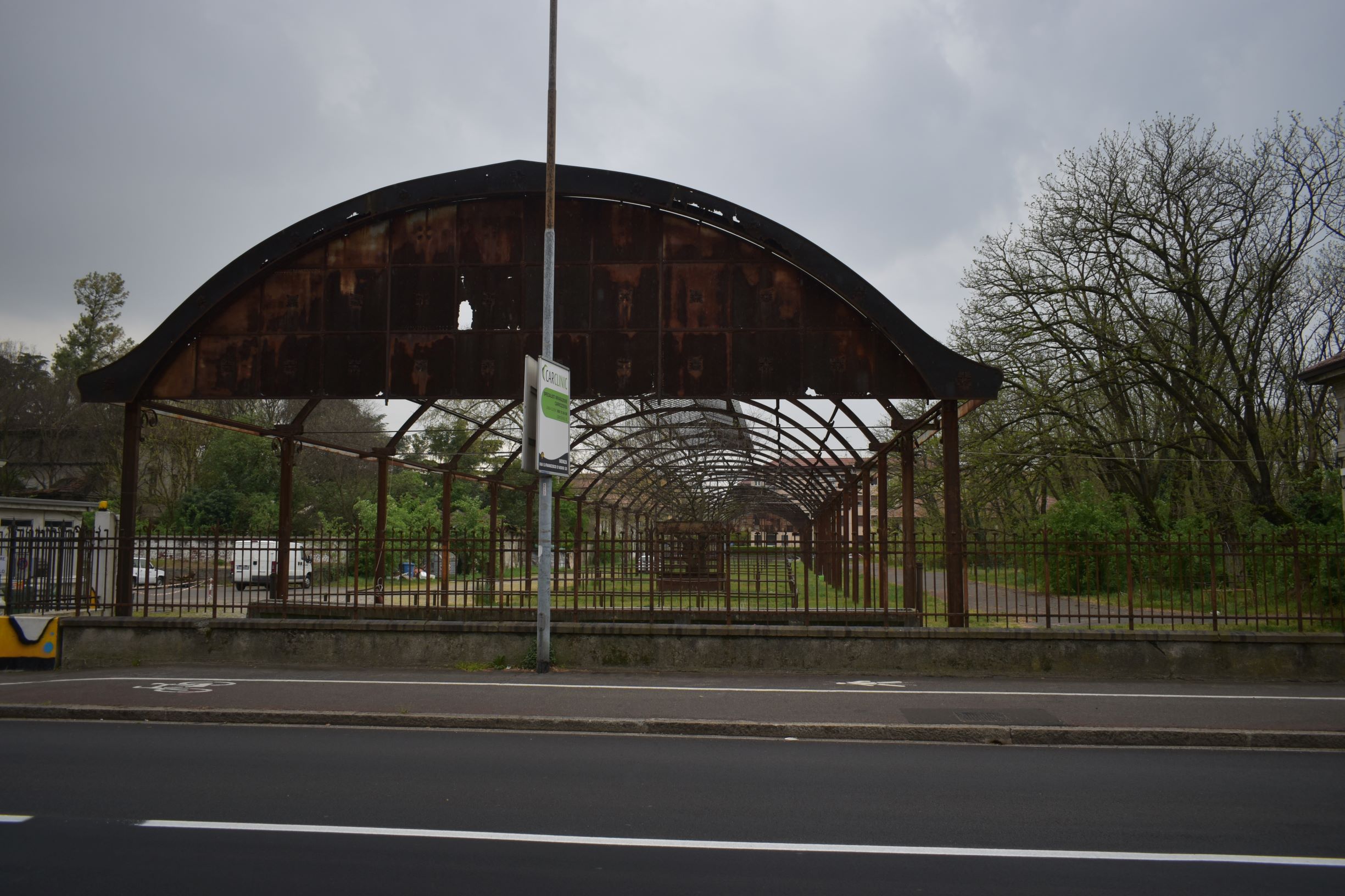
The old market and slaughterhouse in via Mentana where the Wehrmacht established a base during the occupation of Monza
German occupation also meant economic exploitation and several German organisations were based in Monza for this specific purpose, The Rusting und Kriegproduktion (RUK) was responsible for German war Production and supervising industrial production in Italy for the German War effort. The Rustingskommado in Milan had a sub-office in Monza based in the Casa di Fascio, under Major Cremer. Also active in Monza, was the Transportbrigade Speer, which as the name suggests was responsible for requisitioning vehicles for use by the Germans. They were based in the Caserma Pastrengo in via Lecco with vehicle deposits at the Cascina San Fedele and a the Hippodromo ( in the park) . The LandwirtsscaftsFuehrer at via Zucchi 13, was responsible for controlling local agricultural production in the area. Other depots were established in Monza for collecting, metalworks, non-ferrous metals, and necessities for German troops.

The Casa di Fascio in central Monza, now the Tax Office
While the Germans had established their various centres for controlling the territory and its economic exploitation, the were relatively few in numbers and continued to rely on local Italian entities to support them. Slightly closer to the station, the old Carcere Penitenziara , was used for the temporary imprisonment of many of those detained in Monza, before they were sent to Milan’s San Vittore Prison, thence to the transit camp at Fossoli , before being deported into the Nazi Camp System Closer to the town centre Just behind the station, the Sicherungskompanie and its Italian helpers had established another lace of detention and torture at the ex Casa Ballila or GIL, an imposing piece of Fascist Architecture. Actually in the town centre, the Fascist Militia occupied the Casa di Fascio , which again became a place if detention and torture. The local authorities, in the form of Monza’s fascist Podesta ,continued to operate from the town hall in piazza Trento e Trieste , while the PS and Real Carabinieri operated from the barracks in via Volturno near to the railway station. That then was more or less the picture of the German occupation forces in Monza in 1943 to 1945, where they had established a nexus of repression and control, not just over the city of Monza but the surrounding area of Brianza and Como.

The Casa di Ballila ( GIL) base for both the SS and Fascist units, became a place of torture and murder. Now a theatre and arts centre.
The above places were to become notorious for killing and torture during the 18 months during which the Germans occupied Monza. Further monuments around the city commemorate those who were killed during partisan actions, tortured and summarily executed or deported during this period.
From Armistice to Liberation
On 8 September 1943, the Italian Royal Government signed an Armistice with the Allies who were fighting their way up the Peninsula from the South. The Royal Government fled to Brindisi, while German troops poured over the Brenner pass to occupy the central and Northern parts of the country. Mussolini was freed from imprisonment and established the Repubblica Sociale Italiana, based in the area around Lake Garda, the Republic of Salo. Italy was therefore split in two , between the Allied occupied Kingdom of the South and the German occupied RSI. Italian Royal troops in the North, confused and lacking in an orders from he Royal Government, largely failed to resist the German occupation and were disarmed by the Germans. Large number of Italian soldiers simply went home, the more fortune managed to cross the border into Switzerland, while some 600,000 others were interned and used as forced labour in Germany ( many of whim were to never return home). On 11 September 1943, German troops occupied Monza.
Resistance activity in Monza commenced shortly after the occupation The first notable event was the attempted assassination of Luigi Gatti. On 20 October 1943, two gunmen from the partisan formation, 3 Gap, waited for Gatti in via Carlo Alberto , in the centre of the city and shot him several times., their aim was not good and although severely wounded Gatti survived. The local Fascist Reggente, Luigi Ast swore that if Gatti died, the ten “subversives” would be executed in revenge. As it happened, it was the recovering Gatti who apparently countermanded this order. Less fortunate was local industrialist and long-time Fascist adherent Gerolamo Crivelli, assassinated as he cycled home from work on 25 November 1943. Again his family requested that no reprisals be taken, Thereafter the campaign continued with a series of bomb attacks, sabotage of the railway lines and the distribution of propaganda leaflets.
While many of the resisters in Monza worked for the big industrial complexes of Milan and nearby Sesto San Giovanni, Monza was a substantial industrial centre, with the establishments of Philips, Hensemberger, CGS and Singer, all of these units contained cells who cooperated with the resistance. When a general strike started in Milan on 1 March 1944, the machines at Hensemberger, and Philips also stopped working, while at Singer the Germans forced the employees back to work at gun point. In a 31 Monzese workers were detained in connection with the March 1944 strikes and deported to Germany, only six returned alive. The last big strike before liberation occurred at CGS in via Marsala on 17 April 1945, where the mainly female work force went on strike offer pay and conditions in general.
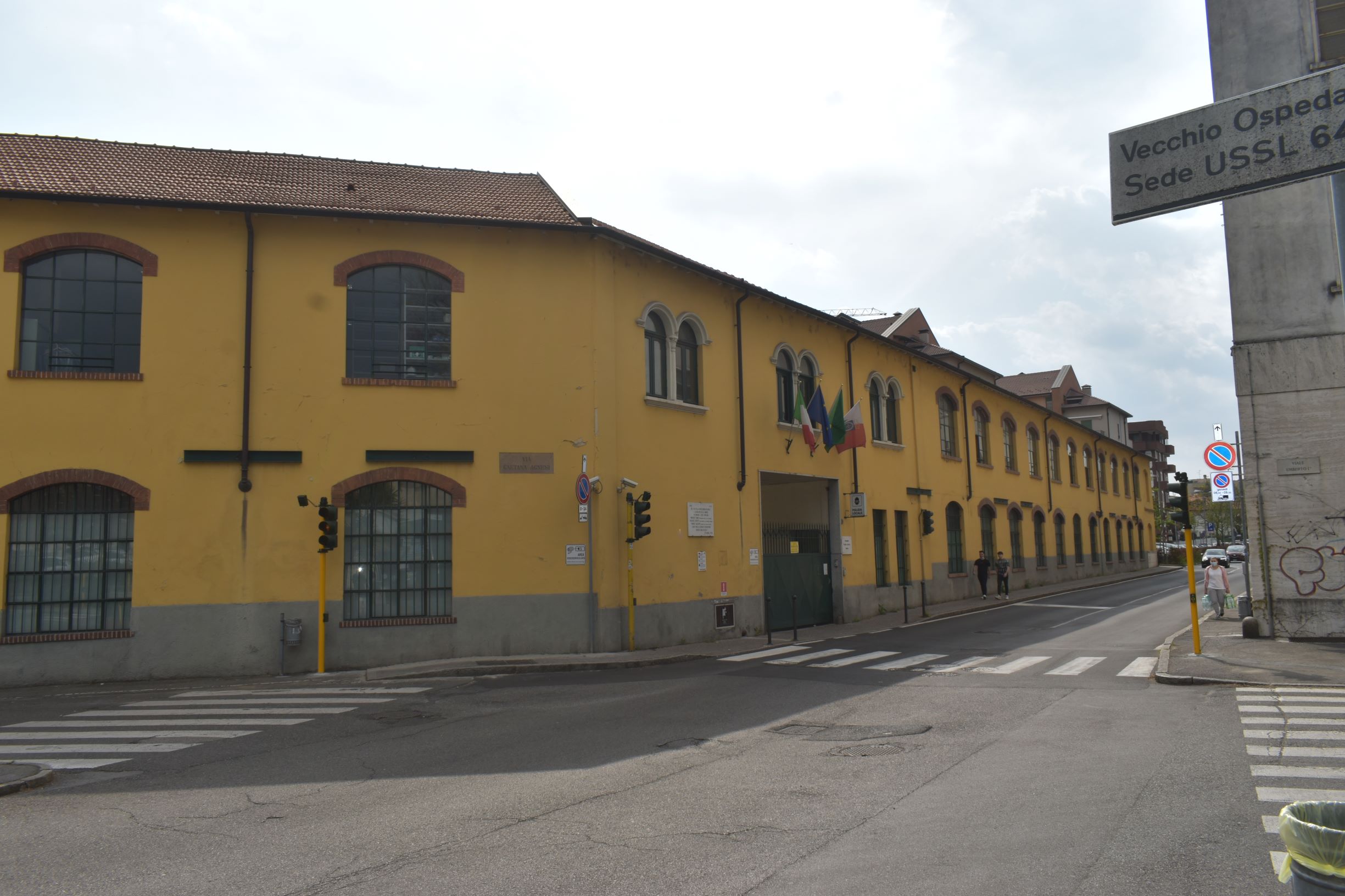
All that remains of the Singer factory in via Marsala, Executed partisan Alberto Paleari worked here.
One notable partisan family in Monza, where the Bracesco family. The family had been longstanding anti-fascists. Carlo Bracesco was one of the original funders of the Partita Comunista in Monza, after the Livorno Socialist Conference. The Brasescos ran an Osteria in via Luciano Manara 28 , which became a renowned anti-Fascist meeting point and the family provided support to opponents of the regime and their families who were being persecuted for their political beliefs . After the Armistice, Carlo and family as very well-known anti-fascists were advised to leave town and hid out at Domaso on Lake Como for a while. In the end they decided to return to Monza and the Osteria Bracesco once again became a centre of resistance activities, for the exchange of messages and publications and clandestine meetings. Carlo’s younger brother Enrico Bracesco was also part of the Monza communist cell. He worked at the Breda Engineering Works (Section V) where he had been active in organizing strikes in March 1943. In 1 June 1943, he had already been tried and imprisoned for his involvement in the strikes, and of course fired from Breda. After the Armistice, he became an active resister, organizing activities in at Breda and then as one of the first members of the GA in the mountains. Enrico’s specialty was supplying guns to resistance groups. It was while returning from one of these missions, that Enrico was involved tin a serious traffic accident, which necessitated the amputation of his leg. He was arrested on 13 March 1944, and being unfit for work because of his amputation, he ended up at the extermination Centre of Castle Hartheim in Austria, where he was murdered.

The site of the Osteria Bracesco, via Luciano Manara 28
While the Germans and their RSI allies waged war on the partisans, they still had time to continue their activities against the city’s small Jewish population. Following the passing of the Italian Racial Laws in 1938, the authorities carried out a census of the country’s Jewish population. In Monza only two Jewish families were recorded. The Colombo family, lived at via Como 15 (now via Carlo di Prina) . Alessandro Colombo ( b. 1875) and Ilda Zamoranti ( b. 1880), eldest son Giorgio and family and younger son Pietro. Alessandro Colombo had worked as a public servant for the Comune of Monza and the local Ospedale San Gerardo, he had been a member of the Partita Nazionale Fascista ( PNF) but this was to prove of little help to him. As a result of the Racial Laws, the family had dismissed from jobs, and their rights severely restricted – but the Italians had no policy of extermination for their Jewish population. All that changed with the Armistice, when the occupying Germans began to round up Italy’s Jewish population. It must be said that, while some years out of date, the 1938 Census proved a useful tool for this. In Milan, many Jews of the same age as Alessandro Colombo and Ilda Zamoranti stayed , erroneously convinced that because of their age the Germans would . nothing to them. However, Monza was a much smaller place and quite wisely after 8 September 1943, the family left the city. Giorgio and family fled to the Marche Region, while Alessandro , Ilda and the younger son Pietro went into hiding in the relative anonymity of Milan. Alessandro made the fatal error of going back to the house in Monza to collect some family memorabilia, he was spotted and betrayed. Unfortunately, in occupied Italy, there was no shortage of individuals who were prepared to betray their former neighbours or colleagues- either for money or other motives. Alessandro was taken to the Carcere in Monza and then to the Jewish wing of Milan’s notorious San Vittore Prison Ilda surrendered to the authorities to be with her husband. On 6 December 1943, they were taken to Binario 21 of Milan’s central Station and put on the first deportation train which left Milan for Auschwitz. Due to their advanced age the couple were murdered by Zyklon B gas immediately on arrival, on or around the 11 January 1944. The other Jewish family recorded in Monza in 1938, were the Levi family resident in via Preterio 7 in the centre of the city, Giorgio Levi (born in Modena in 1898) , his wife Eva and sons Umberto and Jaffet. On 4 December 1943. Giorgio Levi was arrested and sent to San Vittore Prison, he spent months there before being transferred to the transit camp at Fossoli and was then sent to join a transport from Verona to Auschwitz. Being younger than the Colombos, Giorgio passed the selection test and was sent to work. He is believed to have died on one of the death marches from Auschwitz to the west after the Germans abandoned the camp to the advancing Red Army. Several Jewish refugees were also detained in Monza during a German round up. Monza was the centre foe several large clinics and sanatoria, established by doctors from Milan. Many Jewish refugees sheltered in these places, sometimes feigning ill health or mental illness as a cover. It did not help them much, the German raids were based on good information and a number of the refugees were picked up and deported.
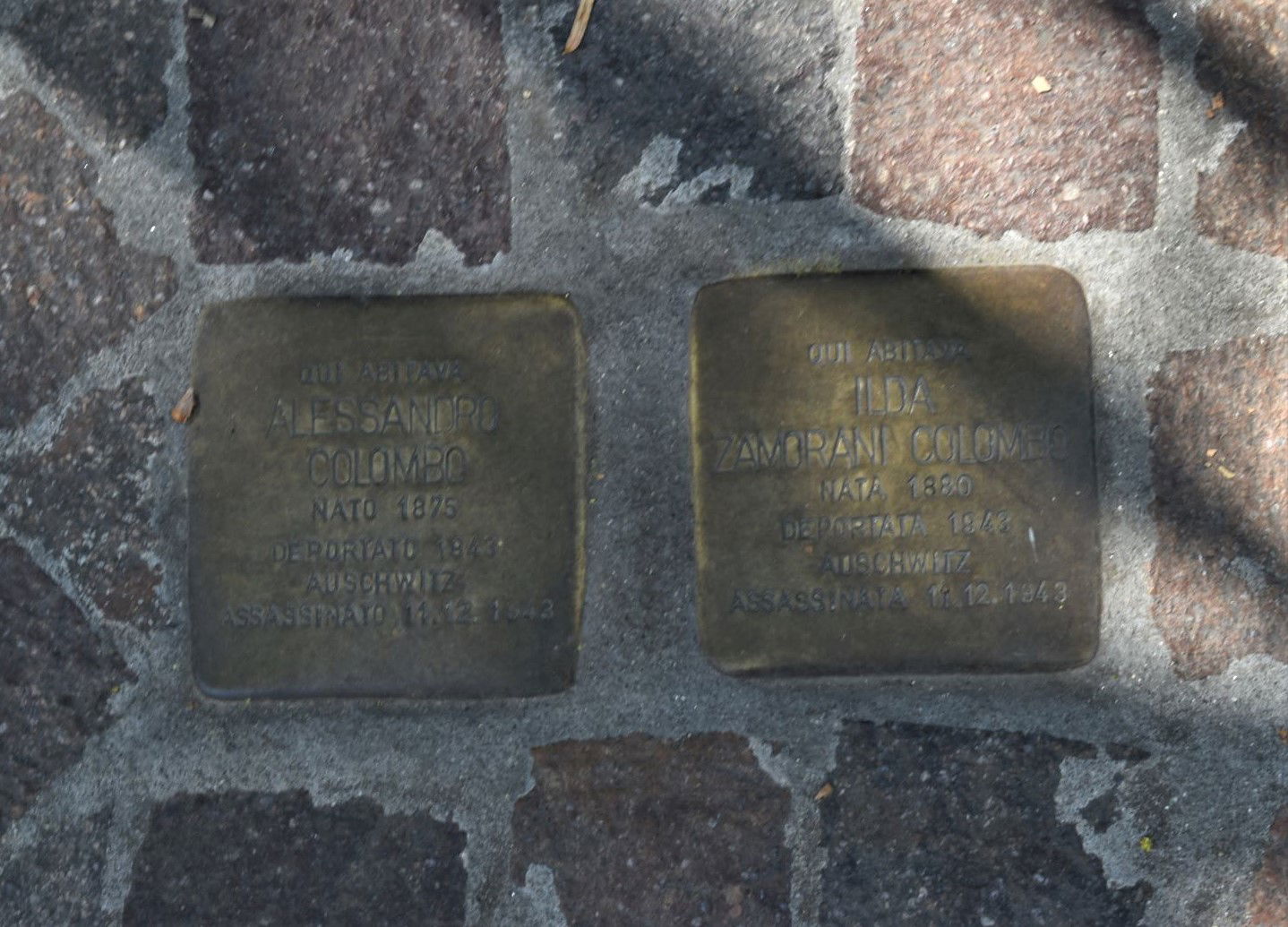
Stolpersteine installed in via Prina in memory of Alessandro Colombo and Ilda Zamoranti.
0n 9 April 1944, at the Casermone barracks, near the Rondo, five young soldiers from Brescia, aged between 20 and 22 who were stationed with the anti-aircraft battery made the mistake of singing the subversive anthem Bandiera Rossa while in the barracks. Despite the pleadings of some of the NCOs, the officers instructed them to be taken into the courtyard of the barracks where they were summarily shot.
In the summer of 1944, the partisan campaign moved up a few gears. A large group of partisans, dressed as Republican soldiers attacked the barracks in vi Lecco, in a daring raid in which they managed to disarm the small garrison and make off with a supply of weapons. Another source of weapons was the frequent disarming of single Republican soldiers, which provided a steady supply of pistols to the resistance. These attacks were so frequent that they prompted the Head of the GNR in Monza, to instruct his men to show a “greater fighting spirit” if they were confronted by resisters trying to steal their side-arms. On 4 September 1994, partisans had another attempt to kill Gatti. He was passing sometime with his wife at a hotel in the mountains of the Valssasina. The day of the attempt, Gatti changed his plans and let his wife use the official car. She was killed together with another woman, the driver, and a GNR official when partisans attacked the car . More typical attacks, were the sabotage of railway lines to attempt to derail trains an attacks on te telephone system These continuing low-level attacks were met by intensifying levels of repression by the Germans and their Republican allies.
Throughout the period, the inhabitants of Monza also had to put up with Allied Bombing. The city had first been bombed on 17 June 1940,, ( seven 7 days after Italy had declared war on Britain and France). On that day a pathfinder bomber had dropped flares over the city followed by a small bombing attack, which destroyed one house in via Cavallotti , causing two minor casualties. It is assumed that the attack was for demonstration purposes and to damage Italian morale. Fortunately Mona escaped largely unscathed, compared to the destruction that Allied Bombers caused in Milan. In fact, so little damage was incurred that the city became a haven for Milanese fleeing their bombed-out city. Occasional air raids caused some damage, but the damage was relatively light. As the Allies advanced up the Italian Peninsula, the greatest peril came from Allied fighter bombers, which would launch low level attacks against railways, trams and roads, strafing them with machine guns and dropping smaller bombs. Numerous attacks were made on Monza’s station, destroying rolling stick and rail infrastructure. A raid on the station area in January 1945 killed 12 people and injured 23. Previously in October1944, several people were killed when a fighter strafed a tram en -route from Monza to Bergamo. On 7 March 1945, an Allied bomb series damaged the Casa di Ballila, presumably the Allies were not aware that it was being used to detain Partisans who were fighting on their side.
On 7 November 1944, Alberto Paleari and Giuseppe Centemero were lunching at the Osteria dell’Uva in piazza Carriobolo , not far from the Boschetti of the Villa Reale. Alberto Paleari was a native of Monza who worked at the Singer Factory in via Marsala. At the time of the Armistice on 8 September 1943, he was serving with the Italian Army in Croatia. He was taken prisoner by the Germans and managed to escape from a holding centre for Italian Military Internees and make his way back to Monza. While working at Singer, he was selected to be sent to work in Germany. Once gain he escaped and joined the partisan formation, the 104 Brigata Garibaldi ( Diomede) . A year older than Paleari, Centemero. was the commander of 104 Brigata Garibaldi. In 1937, he had been recruited into the Italian Army and participated in the campaigns in France, Greece and Russia. After the Armistice, he too had joined the partisans. Centemero lived clandestinely and travelled on false papers- but he must have felt secure enough to visit an Osteria in the centre of Monza. It turned out to be a fatal error. Paleari and Centemero were spotted in the restaurant, they were dragged out by members of the Brigata Nera and marched the half or mile or so to the Casa di Fascio in the centre of the city. There they were tortured for the whole afternoon and throughout the night. The next morning they are dragged out into the piazza Trento e Trieste, where the Brigata Nera shot them in public forcing passers-by to watch, They had been beaten and tortured so badly , that their bodies were unrecognizable. Possibly they were already dead when the Fascists” staged” their execution for public effect. (Although the site of their “execution” is now covered by a large office block and the OVS department store ) Paleari and Centemero are commemorated by a plaque nearby the site )
In December 1944, Salvatrice Benincasa was taken to the GIL ( Casa di Ballila) , tortured and then thrown into the River Lambro from the Bridge in via Mentana. Most probably she died of her injuries and the cold having been thrown not the freezing water. Salvatrice was born in Catania, Sicily in 1924 and at the age of two her family transferred to Trieste for work and then to Milan, where he worked for Montecatini. The family lived at via Venini 4, near Milan’ Central Station, and apparently had socialist tendencies. After the Armistice, Salvatrice, adopting the name Mara, seems to have worked as a spy for the resistance . She ended up in Monza, presumably on a secret mission, where she was staying at the Hotel Falcone near the station. It appears that “Mara” was known to the SS. It may be that her mission was to infiltrate Tensfeld’s HQ and find out more about anti-partisan activity. Apparently Mara, asked to be introduced to Tensfeld and his Intelligence officer, Jöst . On 15 December 1944, she me with Jost, with an Italian interpreter present, Dino Pigoni ( who apparently provided most of the evidence on this). She returned to the Hotel Falcone, but it was clear that she was also under suspicion and being watched by Italian agents of Werning’s SK. That evening she was arrested at the hotel and taken the short distance over the railway bridge to the GIL, having been denounced for spying. Salvatrice, was violently interrogated and tortured in the in the presence of Werning and Pigoni. Later, the guards at the GIL summoned a nearby nurse to provide medical attention to a young female detainee. According to witnesses she was handed over to Dino Colombo another of Werning’s agents, and is reported to have “died while escaping”- In fact she was thrown into the river and left to die. Strangely that evening her body was recovered and sometime around midnight an SS truck dumped her body at the municipal cemetery. All her identity documents had been removed and she was buried as “unknown”, not being properly identified until April 1945. In the end Salvatrice received a decent burial at the Monumental Cemetery in Milan at the request of the CLN.

Memorial to Salvatrice Benincasa on the bridge in via Mentana where she was killed.
In January 1945, Vittorio Michellini and Alfredo Ratti planned a raid on the PS barracks in via Volturno to steal weapons from the magazine. Michellini and Ratti were members of the Fronte di Gioventu, a non-sectarian resistance organization founded the physicist Eugenio Curiel. The core group of the Fronte in Monza was formed by Piero Gambacorti Passerini, Silvio Arosio, Silvio Besana , Amos Crotti and Silvio Vetti. For the proposed raid on the barracks in via Volturno, they had an inside man a anti-Fascist Police official, Raffaele Cristicello (originally from Avellino). Cristicello apparently supplied them with the plans of the building and location of the armoury. On 24 January, the members of the group drew straws ad Michellini and Ratti were selected to carry out the raid. Meanwhile other members of the group staged diversions by daubing anti-fascist slogans in red on the Liceo Zucchi and the Arengario in the centre of the city. Michelini and Ratti carried out their raid successfully and escaped with the arms. As they were returning home, they were caught by a patrol in the security zone around the SS Quadrilateral, whether they had gone there with the intention o carrying out an attack is unclear. Michellini and Ratti were taken to the offices of the UPI in the nearby Villa Reale where they were beaten and tortured. They were joined by Cristicello who had also been detained. The next day all three men were put up against the external wall of the Villa Reale in via Boccaccio and shot.
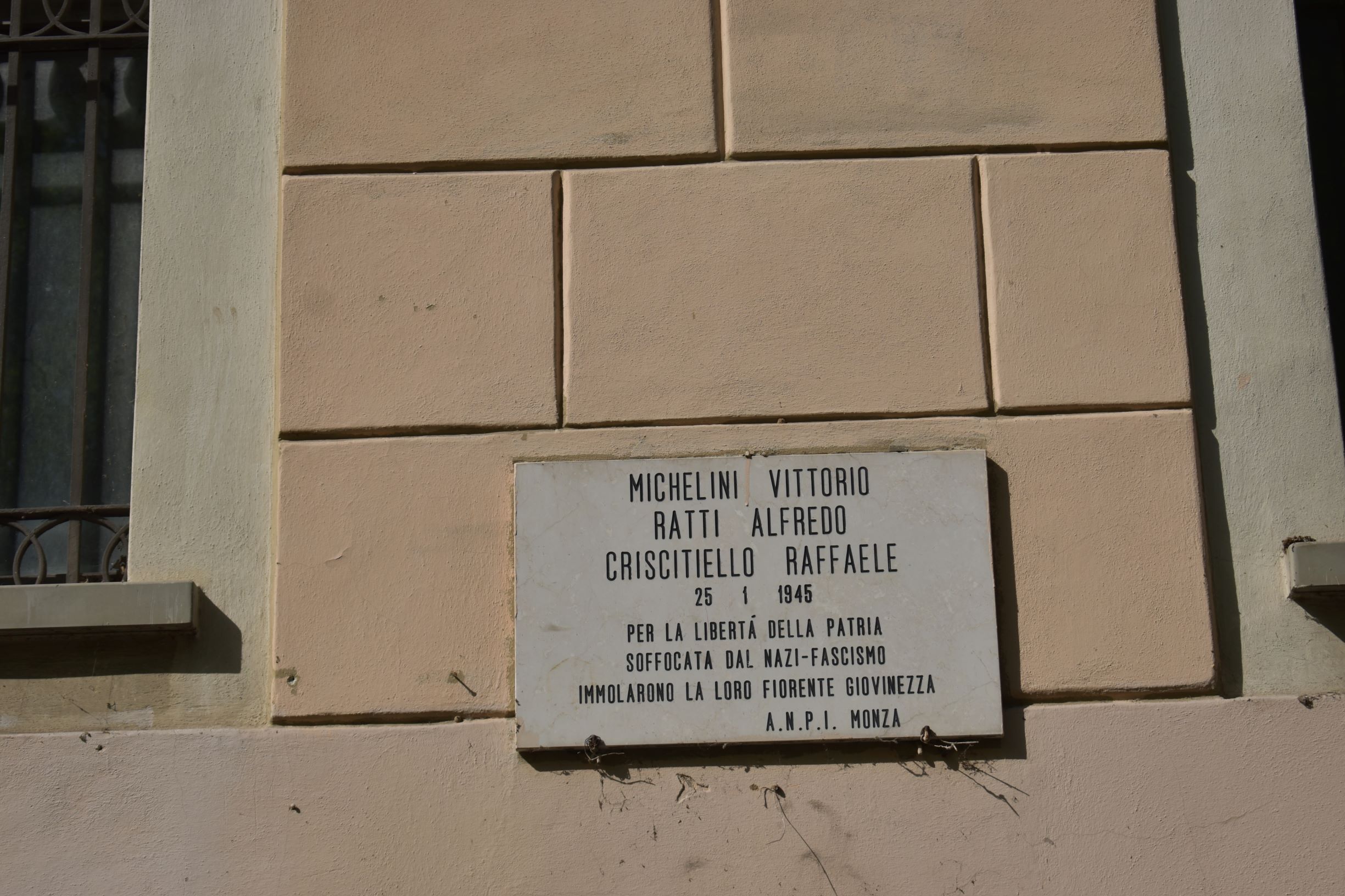
Memorial to Vittorio Michelini, Alfredo Ratti and Raffaele Criscitiello on the wall outside the Villa Reale where they were shot.
Even as the Allies advanced from their winter holding line in the Apennines and the war for the Germans and their allies in the RSI was all but lost, the killings in Monza continued. On 16 March, a German NCO, Frit Bachel was walking with an Italian woman in via Silvio Pellico near to the Wehrmacht HQ at the -market/ slaughterhouse. The NCO was shot dead, by persons unknown- it is not clear whether it was a partisan attack or just an opportunistic killing. Whatever the motives, the Germans randomly selected five partisan inmates from the nearby Monza prison, marched the few hundred metres to via Pellico and shot them in the same place the NCO had been killed. The men were Angelo Inzoli, Giuseppe Malfasi and Luigi Dell’Orto of the 111 Brigata Matteotti and Pietro Colombo and Gianfredo Vignati of the 102 Brigata Matteotti. In accordance with their usual practice, the Germans forced several passers-by to witness the shootings.
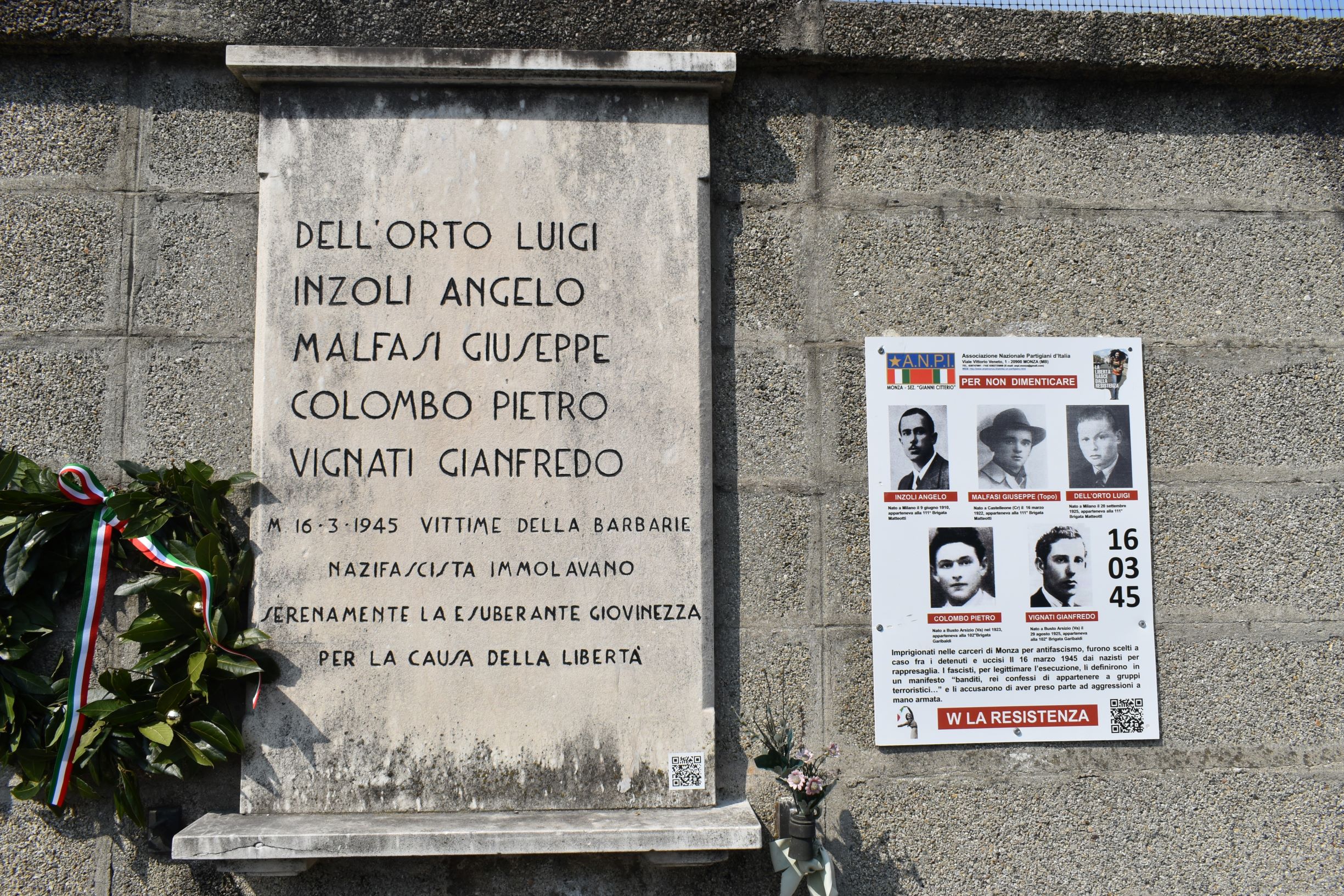
Memorial in via Silvio Pellico to the five partisans taken from the prison and shot in revenge for the killing of a German NCO
The last partisan deaths in Monza took place during the insurrection on n 25/26 April 1945.On 25 April, a general uprising began in Genoa which spread to Milan. In Milan, the occupying Germans were thinly spread over a large city and the partisan numbers were also proportionately larger. After street fighting in many area, the partisans secured large parts of the city. In Monza, the partisans were smaller in number and relatively inexperienced. The position was complicated by the large number of SS troops still in the city. As partisans’ groups converged on Monza from the outlying areas, partisans in the city finally launched an uprising. Carlo Mengoni was shot and killed as they attacked the barracks of San Paolo in the centre of the city on 26 April 1945.

The San Paulo barracks in piazza San Paolo scene of fighting on 25 April 1945.
While the insurrection continued, SS Brigadefuehrer Tensfeld remained holed up with some 300 men, in the fortified quadrilateral. The partisans attempted to negotiate his surrender, but he affirmed that he would only surrender to the advancing Allies. Presumably aware that his cause was totally lost, Tensfeld agreed that his men would stay in their area and not interfere with the insurrection. On 29 April, units of the American 1st Armored Division entered Monza but Tensfeld still refused to surrender, until an America general could be found for him to surrender to. As the Germans evacuated Monza, American tanks rolled down viale Cesare Battistini to take over the city. Tensfeld was transferred into British custody. In 1947, the British tried him for War Crimes, specifically, two counts involving the murder of an escaped British POW detained with partisans and a massacre of partisans. Tensfeld was acquitted on both counts, and returned to the Federal Republic of Germany, where he died in Hamburg at the age of 82. The Italians took no action against him. The notorious torturer SS Unterscharfuehrer Werning, simply disappeared after 30 April 1945 and was never seen again. Less fortunate was Maggiore Luigi Ratti , the UPI's chief torturer at the Villa Reale. He was a local man, so he could not get far. Ratti was picked up by local partisans and executed in the Boschetti of the Villa Reale, not far from the spot where Michellini, Ratti and Cristicello were shot.